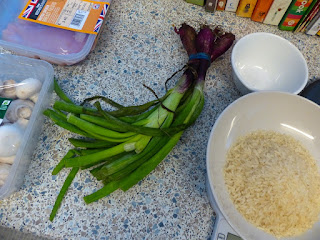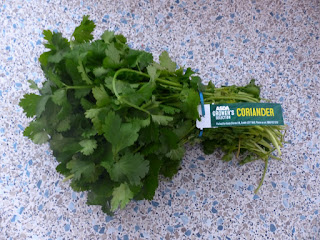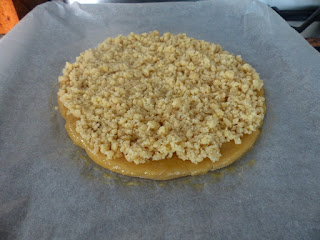The recipe: p114, "Ginger Chicken with Coconut Rice"
While The Random Kitchen is ultimately a self-indulgent little project, I'm grateful to have acquired a modestly sized but surprisingly fervent base of readers who have consistently engaged with my ups and downs, made the right "eww" noises at my terrible photographs, peer-pressured me into making meringue swans, and occasionally even donated me their ridiculous cookbooks. I've come to expect and greatly appreciate the entertaining and funny comments I get every time I share one of these blogs on my socials.
What I never expected was for an anonymous reader to send me a life-size cardboard cut-out of Ainsley Harriott.
Well, I say anonymous. The targeted misspelling of my name on the delivery label, plus the fact that a 40th birthday party I attended in the not too distant past involved Sir Cliff Richard in cardboard cut-out form, meant I had a strong suspicion.
A WhatsApp exchange followed:
(If you heard that reply in this voice, you're not the only one.)
What can I say? Apparently this household is now home to a cardboard Ainsley, the man whose every contents page launches a thousand bad quips.
I reiterate what I said on WhatsApp: for fuck's sake.
Anyway. For all it arrived a few weeks ago, I think it's only right that I waited until the next encounter with Meals In Minutes before unleashing the full Ainsley on this blog. Even if this recipe isn't really the "full" Ainsley - it has a sensible name, for a start. But honestly, in a week when I have to try and explain the presence of a giant fucking Ainsley Harriott in my house, I'm glad to have a fairly straightforward recipe to blog about...
The prep: I had a sense of déjà vu when reading the recipe for "Ginger Chicken and Coconut Rice" (seriously? not even "Nutty Chick 'n' Ginger"?), until a spot of targeted searching made me realise I was thinking of the Sichuan Orange Beef recipe from the original Random Kitchen, which also involved mushrooms, oranges, spring onions and some unnecessary garnishes. (Spoiler alert.)
Technically I'm allowed to veto anything that's too similar - no point in blogging the same stuff twice - but the fact that this is a chicken dish already satisfies the "different enough" criterion, so on we go.
The main compromise I'm going to have to make here is that the recipe calls for skin-on chicken breasts, and getting hold of them at Lewisham Asda proves surprisingly difficult, by which I mean impossible. I feel like the skin would up the "authentically oriental" score of this dish - not that it's claiming to be authentic, but the ingredients at least suggest we're looking in that general direction - so it's a shame, but skinless will have to do. Healthier, at least, innit?
Other than that, most of what I need is already in the house. The recipe calls for two bunches of salad onions (honestly, is there a more useless measure than the "bunch"?), but I think the colourful single bunch that was in the veg box this week should be substantial enough:
Lewisham Asda does at least provide me with a block of creamed coconut
from its mighty "Jamaican/Indian/Polish/preserved lemons" aisle of
randomness. Meanwhile, I'm usually lazy when it comes to ginger (the stuff from a jar is fine for most purposes), but since it's actually in the title here, I figure I should buy fresh. Even if my bits of ginger root do look unnervingly like potatoes.
The making: You're going to enjoy the first instruction here. Are you ready? Here we go: "Heat the oil in a frying pan and cook the chicken, skin-side down, for 2-3 minutes on each side until golden brown."
Cook the chicken skin-side down. On each side. Good good.
Anyway, my breasts are skinless so it's a moot point. Having browned my breasts, they go into an ovenproof dish and I mix together the marinade-slash-sauce, which involves honey, soy sauce, crushed garlic, grated ginger, and the grated rind and juice of an orange. For a while, this doesn't look like it's going to turn out terribly well...
...but we get there in the end, more or less.
This is then poured over the chicken, and into the oven it goes. There is "basting" involved later in the process, which is a bit surprising considering how little liquid there appears to be here:
...but there we go. After ten minutes in the oven, I remove the dish and add some halved button mushrooms and the salad onions, "trimmed and halved". Hard to say what exactly is meant by "halved" here - lengthways, I guess? The photo accompanying the recipe suggests that we might actually be talking crossways, but that seems a bit excessive given my onions are quite substantial, so I compromise on this:
Seems all right. There's not really enough room in the dish for me to successfully baste the chicken, onions and 225g of mushrooms with what is a minimal amount of liquid anyway, but I do my best and back into the oven it goes.
In the meantime, I make the coconut rice. Like so often recently, this involves a rice-to-water ratio that I'm not entirely happy with - just 400ml of water for 200g of long-grain rice - and when a good amount of that water boils off in the time it takes for the creamed coconut to dissolve, I'm forced to improvise a little. The end result (with just "12-15 minutes" as the required cooking time) manages to be simultaneously sticky/squishy and a little al dente, which is an impressive and not altogether pleasant combination.
Still, it's good enough, and that means it's time to assemble the finished dish. Which I think I've done:
...until I remember the "garnish": orange wedges and bay leaves.
Well, okay. I find garnish to be a fairly useless concept anyway - you'll have noticed over the years that food presentation isn't exactly my strong point - but sprinkling on something actively inedible like bay leaves seems especially superfluous. Still, rules are rules, so on they go and it's time for us to wolf down this meal in minutes, in minutes.
The eating: It's not particularly coherent, which is to be expected given it's just some chicken, mushrooms and spring onions bound together with a tiny bit of sauce and a lot of hope. But the combination of sweet and savoury flavours - coconut and orange on the one hand, garlic and soy on the other - is nice enough.
And it looks quite pretty in a jumbled kind of way (though my colourful onions help a lot there).
I'm expecting a lot more of a ginger kick, given it's actually named in the title and Ainsley's blurb promises that "the delicious smells coming from the oven once this is on the go will drive your family's tastebud wild". There's nothing especially wildness-inducing here - it's a well-balanced flavour, but that's all. I suspect a 2020 cookbook would be a lot braver on the flavour front than this 1998 tome - we're probably bit more used to punchy flavours being front and centre nowadays, and that's a problem I keep encountering in this blog generally, and where 90s Ainsley is concerned specifically.
And, yes, the orange wedges and bay leaves serve no discernible purpose.
Still, not a bad effort. My miniature worktop Ainsley gets a little pat on the head for this one, but it's not quite nice enough for me to show his big brother any love. I'm still too busy working out what the hell I'm going to do with him...
Three-word verdict: Tastier than cardboard.
 The book: Ainsley Harriott's Meals In Minutes
The book: Ainsley Harriott's Meals In Minutes










 The books:
The books: 




















 The book: Swedish Cakes and Cookies (Sju sorters kakor)
The book: Swedish Cakes and Cookies (Sju sorters kakor)








 The book: Jerusalem (Yotam Ottolenghi and Sami Tamimi)
The book: Jerusalem (Yotam Ottolenghi and Sami Tamimi)







